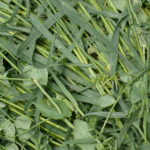
Record acreages of emergency annual forages were seeded this summer after wheat and spring cereals were harvested. Low yields of first- and second-cut hay left many farmers with very low forage inventories. Emergency forages used included cool-season cereals (oats, barley, triticale) and cereal pea mixtures, as well as some warm-season sorghums, sorghum-sudans and millets (pearl, Japanese). Oats were the most frequently used, as a low cost, low risk approach. Yields and nutrient quality of these emergency forages were excellent, with high volumes of palatable quality baleage and silage being made. This strategy provided farmers with a “big save” in meeting their forage needs. For recommendations, refer to “Summer Seeding Oats For Extra Forage” https://fieldcropnews.com/?p=4264.
Cereals Versus Sorghums
Winter wheat harvest was exceptionally early this year, and allowed for very early seeding of emergency forages. Sorghums are more tolerant of hot dry weather than cereals. In situations where seeding dates were very early (early-July) and hot dry weather continued for a few weeks, sorghums yielded better than cereals. As cool-season grasses, oats are not very tolerant of hot dry weather and do not tiller and grow well in these conditions.
However, cereals planted after late-July performed very well. Warm-season grasses, such as sorghums, sorghum-sudans and millets do not grow well in cooler fall weather, and are very sensitive to frost, limiting yield potential. After the first frost, there is a very narrow harvest window before forage quality drops significantly. There are also some concerns about potential prussic acid poisoning with the sorghums. Oats will out-perform sorghums in cooler, wet fall weather, and are much more tolerant to hard frosts. They are not killed by frost until -9°C, enabling growth into very late fall, and a much wider harvest window.
Nutrient Quality
A common question is “what is the forage quality of these summer seeded forages?” This depends entirely on maturity at harvest, as well as acceptable moisture levels for successful fermentation. Cereals harvested at flag-leaf or boot-stage will be higher nutrient quality, but lower yielding than cereals harvested at late-head or soft-dough stage. When peas have been added to cereals, nutrient quality can be very high. Some analysis of oat-pea forage mixtures have exceeded good quality alfalfa haylage. There have been some reports of high nitrate levels. If this is a concern, testing for nitrates is recommended, particularly if this forage makes up a high percentage of the diet. Refer to “Potential Nitrate Poisoning” https://fieldcropnews.com/?p=4976.
Harvest Moisture & Fermentation
The challenge in making high quality forage from late-summer seeded cereals is getting them wilted to an acceptable moisture level to allow for a good fermentation. Fall weather tends to be cooler, days are shorter, dews are heavy, and rainfall more frequent, resulting in much slower and more difficult drying. Heavy crops and cereal-pea mixtures are especially challenging. Farmers continued to harvest forage cereals and hay fields in late-October and into November, when weather suitable for wilting was almost non-existent. Generally, silage over 70% moisture and baleage over 55% moisture tends to be more prone to inefficient clostridial fermentations, especially if they were raked and soil was incorporated into the swath. This leads to high levels of butyric acid and “stinky, slimy” feed with reduced palatability and quality. Refer to “Silage Fermentation Problems” https://fieldcropnews.com/?p=5592. Grazing this growth in late-fall is a good way to harvest late planted annual forage and avoid the challenges of making wet silage.
If the trend of high land costs and grain prices continues, and hay acreages continue to slip, many farmers may look to summer seeded annual forages on a more regular basis as a method of producing additional forage in a double crop system.